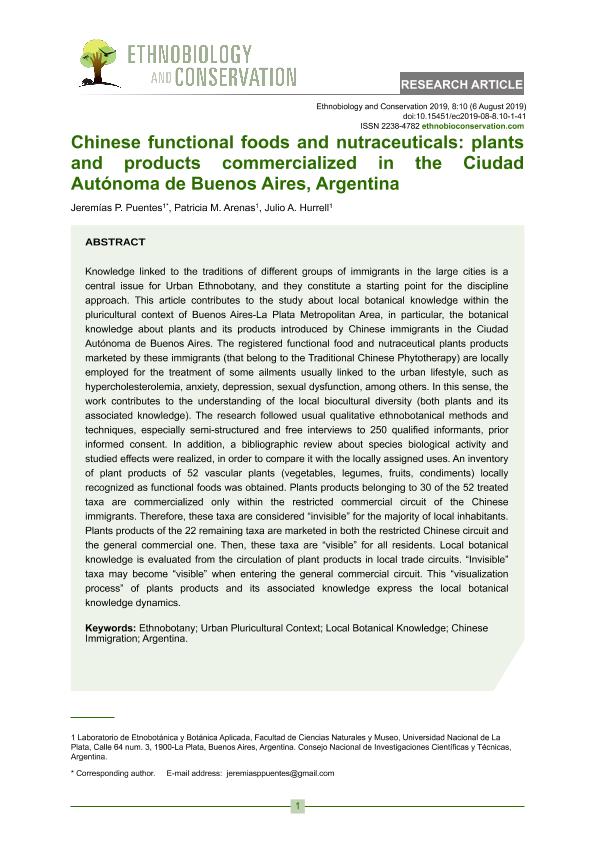Mostrar el registro sencillo del ítem
dc.contributor.author
Puentes, Jeremías Pedro

dc.contributor.author
Arenas, Patricia Marta

dc.contributor.author
Hurrell, Julio Alberto

dc.date.available
2021-03-10T04:18:22Z
dc.date.issued
2019-08-06
dc.identifier.citation
Puentes, Jeremías Pedro; Arenas, Patricia Marta; Hurrell, Julio Alberto; Chinese functional foods and nutraceuticals: plants and products commercialized in the Ciudad Autónoma de Buenos Aires, Argentina; Universidade Federal Rural de Pernambuco; Ethnobiology and Conservation; 8; 10; 6-8-2019; 1-41
dc.identifier.issn
2238-4782
dc.identifier.uri
http://hdl.handle.net/11336/127896
dc.description.abstract
This article contributes to the study about urban botanical knowledge within the pluricultural context of Buenos Aires-La Plata Metropolitan Area, in particular, the botanical knowledge about plants and its products introduced by Chinese immigrants in the Ciudad Autónoma de Buenos Aires. The registered functional food and nutraceutical plants products marketed by these immigrants (that belong to the Traditional Chinese Phytotherapy) are locally employed for the treatment of diseases linked to the urban way of life, such as diabetes, hypercholesterolemia, hypertension, cancer, cognitive dysfunctions, among others. In this sense, the work contributes to the understanding of the local biocultural diversity (both plants and its associated knowledge). The research followed usual qualitative ethnobotanical methods and techniques, especially semi-structured and free interviews to 250 qualified informants, prior informed consent. An inventory of plant products of 52 vascular plants (vegetables, legumes, fruits, condiments) locally recognized as functional foods was obtained. Plants products belonging to 30 of the 52 treated taxa are commercialized only within the restricted commercial circuit of the Chinese immigrants. Therefore, these taxa are considered “invisible” for the majority of local inhabitants. Plants products of the 22 remaining taxa are marketed in both the restricted Chinese circuit and the general commercial one. Then, these taxa are “visible” for all residents. Local botanical knowledge is evaluated from the circulation of plant products in local trade circuits. “Invisible” taxa may become “visible” when entering the general commercial circuit. This “visualization process” of plants products and its associated knowledge express the local botanical knowledge dynamics.
dc.format
application/pdf
dc.language.iso
eng
dc.publisher
Universidade Federal Rural de Pernambuco
dc.rights
info:eu-repo/semantics/openAccess
dc.rights.uri
https://creativecommons.org/licenses/by-nc-sa/2.5/ar/
dc.subject
ETHNOBOTANY
dc.subject
URBAN PLURICULTURAL CONTEXT
dc.subject
LOCAL BOTANICAL KNOWLEDGE
dc.subject
CHINESE IMMIGRATION
dc.subject
ARGENTINA
dc.subject.classification
Otras Humanidades

dc.subject.classification
Otras Humanidades

dc.subject.classification
HUMANIDADES

dc.title
Chinese functional foods and nutraceuticals: plants and products commercialized in the Ciudad Autónoma de Buenos Aires, Argentina
dc.type
info:eu-repo/semantics/article
dc.type
info:ar-repo/semantics/artículo
dc.type
info:eu-repo/semantics/publishedVersion
dc.date.updated
2021-03-05T18:59:58Z
dc.journal.volume
8
dc.journal.number
10
dc.journal.pagination
1-41
dc.journal.pais
Brasil

dc.journal.ciudad
Recife
dc.description.fil
Fil: Puentes, Jeremías Pedro. Universidad Nacional de La Plata. Facultad de Ciencias Naturales y Museo. Laboratorio de Etnobotánica y Botánica Aplicada; Argentina. Consejo Nacional de Investigaciones Científicas y Técnicas; Argentina
dc.description.fil
Fil: Arenas, Patricia Marta. Universidad Nacional de La Plata. Facultad de Ciencias Naturales y Museo. Laboratorio de Etnobotánica y Botánica Aplicada; Argentina. Consejo Nacional de Investigaciones Científicas y Técnicas; Argentina
dc.description.fil
Fil: Hurrell, Julio Alberto. Consejo Nacional de Investigaciones Científicas y Técnicas; Argentina. Universidad Nacional de La Plata. Facultad de Ciencias Naturales y Museo. Laboratorio de Etnobotánica y Botánica Aplicada; Argentina
dc.journal.title
Ethnobiology and Conservation
dc.relation.alternativeid
info:eu-repo/semantics/altIdentifier/url/https://ethnobioconservation.com/index.php/ebc/article/view/293
dc.relation.alternativeid
info:eu-repo/semantics/altIdentifier/doi/http://dx.doi.org/10.15451/ec2019-08-8.10-1-41
Archivos asociados
